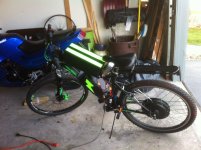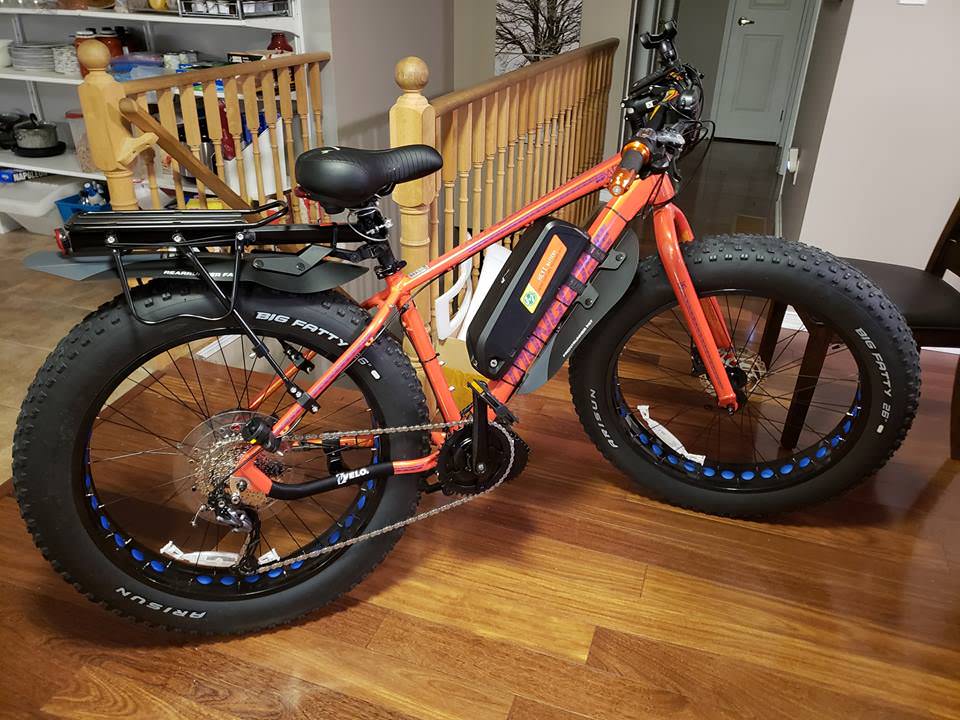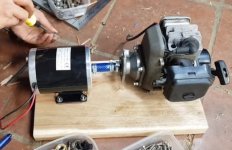Hello. It is time for me to build my "ultimate, final form" motorized bike. It will hopefully be a electric mid drive bike with a small, removable dc gas generator on the rear rack. The bike should be capable of doing 40mph+ and cruise easily in upper 20s and with only the battery (2 kwH) do 30-40 miles at cruise (no wind, no elevation). With the gas generator, I am not sure on the range it will depend on the engine that I can get and if it all works out but I am hoping for some impressive stats with minimum noise (high idle rev). I decided to go this route instead of a 79cc+ motor because I really like the near instant torque, efficiency, and low noise of electric motors, but I am also realistic about the range hence the gas generator. This model is currently being used in most modern locomotives and cruise ships due to power efficiency curves.
I will be using a Walmart Huffy Nighthawk bike that currently has a 500W rear hub motor. I tried to sell this before starting the new build but no serious bids this late into the season so I will just use it. The batteries will be hoverboard/scooter 36V 4.4aH batteries hooked up in parallel then series for 72V. I will be doing this in 3 phases to properly test everything and not overwhelm myself. It should probably take me into spring to get everything correct.
Phase 1 - Upgrading to the 72V 3000W Cyclone SBP mid drive kit from 36V 500W hub drive
Phase 2 - Adding max batteries from 1.2 kwH to 2 kwH and adding wind break fairings and clear pocket bike wind shield
Phase 3 - Adding the 25-49cc gas generator (200-600W) output to the rear rack
Here is the design. Battery1 and B2 are already on the bike. Originally, I did not know where a third battery pack can go but after watching some YouTube videos of big power DYI ebike riders they make a right and left battery compartment (B3) near the stem of the bike to house the batteries. I was gonna put it under the downtube... B3 will allow me to put in a wind fairing too and with a windshield. I should be able to tuck under this to get real aerodynamic? The added weight of B3 should also help prevent the bike from undesired wheelies. All the batteries are removable with simple nuts and bolts for winter and storage. Let me know if there is any concerns with this design. Pic of current bike too.
Also, this will be a minimal cost build. Not that I am gonna cheap out on absolutely necessary items but it wont be top of the line components and do a lot of DYI. I will do a thorough documentation of this build and thought analysis. The hybrid concept is cool. I know some electric bike guys would never go gas generator and mebe some gas heads here scoof at the range of ebikes, but hopefully this hybrid will be both extremely gas and pollution efficient and also have an incredible 2-3x range of current ebikes. And, the generator is optional and can be easily removed with a few nuts and bolts.
I will be using a Walmart Huffy Nighthawk bike that currently has a 500W rear hub motor. I tried to sell this before starting the new build but no serious bids this late into the season so I will just use it. The batteries will be hoverboard/scooter 36V 4.4aH batteries hooked up in parallel then series for 72V. I will be doing this in 3 phases to properly test everything and not overwhelm myself. It should probably take me into spring to get everything correct.
Phase 1 - Upgrading to the 72V 3000W Cyclone SBP mid drive kit from 36V 500W hub drive
Phase 2 - Adding max batteries from 1.2 kwH to 2 kwH and adding wind break fairings and clear pocket bike wind shield
Phase 3 - Adding the 25-49cc gas generator (200-600W) output to the rear rack
Here is the design. Battery1 and B2 are already on the bike. Originally, I did not know where a third battery pack can go but after watching some YouTube videos of big power DYI ebike riders they make a right and left battery compartment (B3) near the stem of the bike to house the batteries. I was gonna put it under the downtube... B3 will allow me to put in a wind fairing too and with a windshield. I should be able to tuck under this to get real aerodynamic? The added weight of B3 should also help prevent the bike from undesired wheelies. All the batteries are removable with simple nuts and bolts for winter and storage. Let me know if there is any concerns with this design. Pic of current bike too.
Also, this will be a minimal cost build. Not that I am gonna cheap out on absolutely necessary items but it wont be top of the line components and do a lot of DYI. I will do a thorough documentation of this build and thought analysis. The hybrid concept is cool. I know some electric bike guys would never go gas generator and mebe some gas heads here scoof at the range of ebikes, but hopefully this hybrid will be both extremely gas and pollution efficient and also have an incredible 2-3x range of current ebikes. And, the generator is optional and can be easily removed with a few nuts and bolts.




